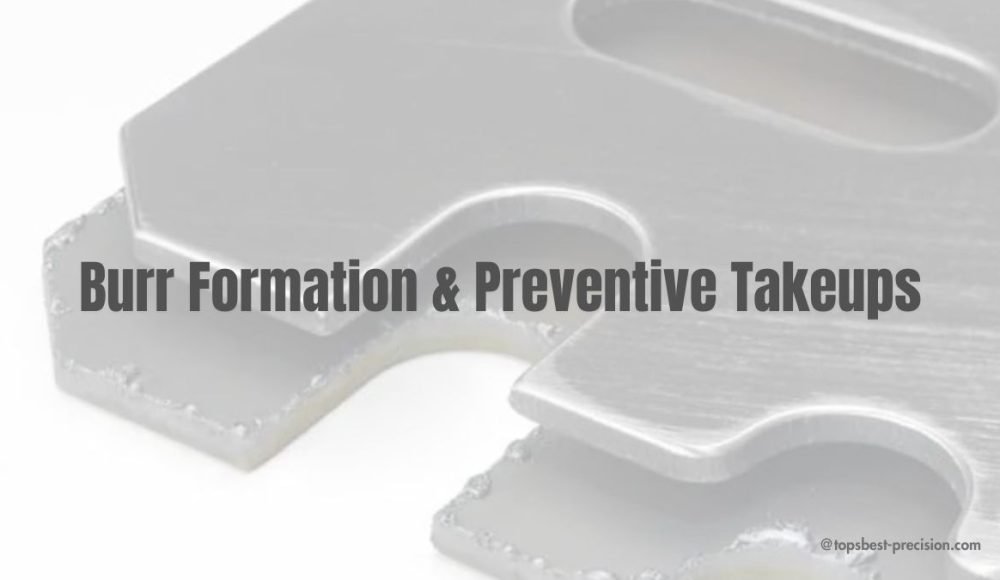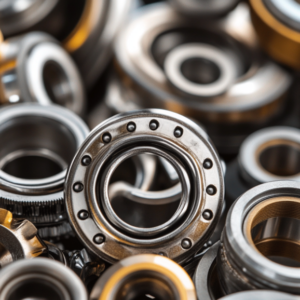Al contratar servicios de corte por láser, Normalmente estás pagando por un trabajo de calidad y un servicio excelente.. Sin embargo, Los bordes afilados pueden ser un problema típico.. En algunos casos, El corte provoca la formación de rebabas., y por lo tanto es necesario desbarbar. El desbarbado tiene muchas técnicas.; Al igual que las rebabas, se pueden crear de muchas maneras.. Entonces, echemos un vistazo a ambos aspectos de este tema..
¿Qué es una rebaba??
Una rebaba se define como una superficie rugosa o un borde elevado en una pieza metálica.. Este problema se observa con mayor frecuencia durante la producción., más comúnmente en el corte de chapa. Las rebabas tienen una gran influencia en la calidad y el rendimiento de las piezas metálicas.. Estos son algunos de los impactos clave de las rebabas.:
- Peligros de seguridad: Los peligros están asociados con los bordes afilados para los operadores..
- Mayor estrés: Las rebabas pueden reducir potencialmente la resistencia a las fracturas..
- Riesgo de corrosión: Los materiales más gruesos también pueden provocar corrosión..
- Problemas de lubricación: Las rebabas también pueden bloquear el flujo y dificultar el funcionamiento del sistema de lubricación..
- Problemas de acabado: Pueden plantear un problema en operaciones como el recubrimiento en polvo..
La prevención de la formación de rebabas es obvia.. Sin embargo, ya que el desbarbado es a menudo el resultado de la fabricación, se vuelve esencial hacerlo.
Formación de rebabas en procesos de fabricación
Las rebabas siempre se desarrollan durante la fabricación de láminas metálicas a través de muchos procesos dependiendo del tipo de pieza.. Estos pueden incluir mecanizado y corte..
Los procesos de mecanizado comunes que dejan rebabas incluyen:
- Molienda: Molienda, Es un proceso idéntico empleado mediante el uso de algún tipo de cortadores.. Estos cortadores afilados giran para afeitar el material.. Entonces, Posibilidades de rebabas asociadas allí..
- Perforación: Deja huecos e incluso podría formar bordes afilados..
- Grabado: Raya la superficie, y puede dejar algunas crestas/rayones.
- Torneado: al girar, la pieza de trabajo gira alrededor de una herramienta de corte, lo que puede provocar la formación de rebabas.
Los procesos de corte utilizados en chapa metálica que producen rebabas incluyen:
- Corte por láser: Corta materiales mediante el uso de luz enfocada..
- Corte por plasma: Utiliza gas ionizado para cortar y dar forma al metal..
- Puñetazos: Empuja un punzón a través del material a cortar..
- Cizallamiento:Corta metal ejerciendo fuerza cortante únicamente..
- Supresión:Corta y/o elimina áreas en chapa metálica..
En términos generales, No todas las técnicas antes mencionadas siempre generan rebabas.. Se sabe que varios otros factores afectan la formación de rebabas.. Tal como, La capacidad del operador y su conocimiento del problema también pueden contribuir en gran medida a reducir las rebabas.. Además, El espesor y el grado del material determinan la facilidad con la que se cortará el material sin que se formen rebabas.. Afortunadamente, La tira de rebabas le da al metal una superficie más lisa porque se pueden quitar..
Tipos de rebabas en la fabricación contemporánea
La fabricación siempre implica la producción de rebabas.. Por lo tanto, los métodos de desbarbado adecuados son cruciales.. Como hay muchos tipos de rebabas., es esencial elegir la forma adecuada de su eliminación para lograr el mejor resultado.
Rebaba de corte
Una rebaba de corte saliente implica una proyección no deseada desde una pieza de trabajo., común cuando las operaciones de corte no alcanzan su objetivo. El tipo deseado se ve a menudo en máquinas de tornillo automáticas o sierras.. Para procesos que exigen precisión, El desbarbado se puede realizar manualmente para eliminar las rebabas de corte..
Rebabas de lágrima
Más, Las rebabas de desgarro ocurren cuando la acción de corte produce más desgarro del material que el corte.. Esto normalmente produce una superficie irregular.. El desbarbado químico quizás sea, el método más eficaz para eliminar estas rebabas de la superficie de la pieza de trabajo acabada. Una técnica utilizada en este caso disuelve las rebabas mientras deja intacto el resto del material.. Entonces, en general, Ayuda a preservar la calidad del producto..
Rebabas de vuelco
De estos, Se producen rebabas por vuelco al cortar., perforación, o operaciones de punzonado. Los fabricantes utilizan máquinas desbarbadoras vibratorias para eliminar estas rebabas.. Estas máquinas están diseñadas para proporcionar vibraciones mecánicas como parte del proceso de eliminación..
Rebabas calientes y afiladas
Las rebabas calientes se forman por ciclos irregulares de calentamiento y enfriamiento.. Si bien las rebabas afiladas son inherentes a los procedimientos de fabricación del acero inoxidable. Ambos presentan un peligro para la seguridad en el entorno de una fábrica.. Para eliminar de forma óptima estas rebabas, Se recomienda el desbarbado térmico.. El desbarbado térmico se aplica para controlar el calor y quemar las rebabas al instante..
Rebabas enrollables
Las rebabas de vuelco también se denominan rebabas de salida.. Ocurren en los lados de la pieza de trabajo por donde sale la herramienta.. Estas rebabas surgen cuando el material se hace rodar con la herramienta y se fuerza sobre una repisa.. El tamaño típico de estas rebabas depende de la profundidad del corte de mecanizado utilizado durante el proceso..
Rebabas Poisson
Se forman rebabas de Poisson en el lado de la pieza de trabajo por donde fluye el material durante el mecanizado.. Específicamente, en el lado donde la herramienta entra por primera vez en el material. La razón principal detrás de su formación es cuando el material se desplaza perpendicular al borde por deformación..
Rebabas de lágrima
Las rebabas por desgarro se producen al arrancar el material de la pieza de trabajo en lugar de al cortarlo.. Este tipo de rebaba es bastante típico para operaciones como el punzonado cuando el material se expulsa con fuerza..
Fugarse / Rebabas de corte
Las rebabas por rotura a menudo ocurren cuando la porción que se corta de cualquier estructura se desprende del cuerpo principal.. Suelen encontrarse en cortes de sierra y productos de máquinas roscadoras automáticas.. Generalmente, da como resultado superficies rugosas.
Rebabas térmicas
Las quemaduras térmicas aparecen durante los procesos térmicos., incluyendo soldadura, moldura, y corte por láser. Estas rebabas también se identifican como escorias o salpicaduras.. Resultan del calentamiento del material y luego su enfriamiento instantáneo durante las etapas de producción..
Técnicas para un desbarbado eficiente
A pesar de, La formación de rebabas no se puede detener durante la fabricación.. hay maneras, sin embargo, para desbarbar las piezas/productos.
Desbarbado químico
El proceso de desbarbado químico elimina únicamente las rebabas en las superficies metálicas mediante el uso de soluciones electrolíticas.. El proceso es especialmente vital en el manejo de rebabas internas que a menudo son difíciles de manejar con técnicas convencionales.. Las pequeñas rebabas son particularmente comunes en las superficies de contacto de piezas como cuerpos de bombas y cuerpos de válvulas..
Desbarbado electrolítico
Proceso de desbarbado electrolítico mediante el cual, vía electrólisis, Se eliminan las rebabas de la superficie del metal.. A pesar de, Este proceso es eficiente y sin duda puede eliminar varias rebabas complejas de las regiones de fácil acceso.. Los siguientes inconvenientes están asociados con el desbarbado electrolítico..
Desventajas del desbarbado electrolítico
- El electrolito es corrosivo y puede empañar las superficies..
- Puede comprometer la estabilidad dimensional cerca de la rebaba..
- Requiere limpieza después del proceso de desbarbado..
- Lo mejor para áreas de difícil acceso, como caries.
Otras clasificaciones de rebabas
Estandarizar la definición de rebabas en diversas industrias., Se han establecido cinco clasificaciones.:
Clase 1: Rebabas de tamaño pequeño que sólo pueden verse con un microscopio..
Clase 2: Rebabas de plumas, pequeñas rebabas que se distinguen fácilmente a simple vista.
Clase 3: Pequeño, rebabas bien adheridas.
Clase 4: Grande, rebabas bien adheridas.
Clase 5: Rebabas extruidas, No son verdaderas rebabas, sino deformaciones del material extruido producidas durante la perforación..
Conclusión
Para mejorar la eficiencia y reducir costes., es importante minimizar el número de procesos de eliminación de rebabas. De este modo, Es recomendable trabajar con un fabricante como Tops Best que proporcionará productos sin rebabas., Limpiar las piezas siempre que sea posible.. Sin embargo, Algunos materiales y espesores pueden crear rebabas en el proceso.. Si sus piezas tienen rebabas en el interior,' el productor también debe ser informado de este hecho.
Si las rebabas son inevitables, Puede elegir un proceso de desbarbado del que se analizó anteriormente en este artículo.. Cuando se trabaja con un lote de piezas, no es aconsejable dedicar tiempo a desbarbarlos manualmente; por lo tanto, implementar un método automatizado. Contáctenos para más información.
Preguntas frecuentes
Q1. ¿Qué son las rebabas y por qué aparecen??
La rebaba se define como una superficie rugosa o borde afilado.. Normalmente, Se desarrollan en una pieza metálica durante un proceso de fabricación.. Pueden ocurrir durante el corte o el mecanizado o cualquier operación térmica.. La formación de rebabas puede tener un impacto significativo en la seguridad y el rendimiento..
Q2. ¿Cuáles son las diversas técnicas de desbarbado??
Algunas de las técnicas habituales de desbarbado son el desbarbado manual., desbarbado con energía térmica, y Desbarbado con energía química. Todos ellos tienen diferente eficiencia y adecuación en cuanto al tipo de fresa y al material utilizado..
Q3. ¿Qué medidas se deben tomar para evitar la formación de rebabas durante el proceso de fabricación??
Para minimizar la formación de rebabas., Es necesario elegir herramientas y métodos de corte adecuados.. Más, óptimamente, Definir los parámetros adecuados de la máquina.. Además, La elección de materiales apropiados y la preservación del nivel adecuado de experiencia de los operadores pueden ayudar a minimizar el problema de la formación de rebabas..
Q4. ¿Qué tipos de materiales son más susceptibles a las rebabas??
Con mayor frecuencia, se sabe que los metales rígidos y algunos plásticos desarrollan rebabas cuando se someten a operaciones de mecanizado y corte..




1 pensamiento en “¿Qué es una rebaba? & Cómo quitarlo?”